Review| Tomorrowland: Hope in the Future?
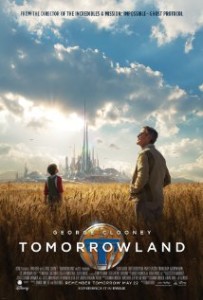 I had a lot of hope in Tomorrowland. It had a lot going for it. I enjoyed the possibility of the concept through the trailers I saw and the entire marketing campaign. The futuristic cityscapes presented were astoundingly detailed. I am also a huge fan of director Brad Bird. Being also a fan of Disney and the Disney Theme Parks, I hoped that these concepts would be transferred to the real-life Tomorrowlands at Disneyland and Walt Disney World and beyond.
I had a lot of hope in Tomorrowland. It had a lot going for it. I enjoyed the possibility of the concept through the trailers I saw and the entire marketing campaign. The futuristic cityscapes presented were astoundingly detailed. I am also a huge fan of director Brad Bird. Being also a fan of Disney and the Disney Theme Parks, I hoped that these concepts would be transferred to the real-life Tomorrowlands at Disneyland and Walt Disney World and beyond.It’s a fun film, but I wanted more, and not in a good way. I suppose I was fascinated more with the idea of Tomorrowland than the finished product.
Despite its grab bag status, Tomorrowland offers very rich thematic ideas about (you guessed it) the future and what’s in store for the world. This film is very spiritual in its premise, but humanistic in its conclusions. In the end, the film is about hope…but what should we put our hope in?
You wanted to see Tomorrowland…here it comes! SPOILERS AHEAD!
The Good
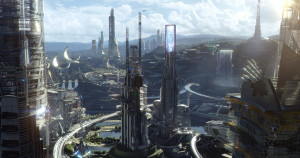 As previously stated, the different parts of Tomorrowland were great. For an old-school sci-fi guy like me, the film offered much in terms of visual style. Everything in the film, especially in Tomorrowland proper, is so interesting to look at. The buildings, vehicles, robots, weapons all have a sort of gee-whiz quality to them that gives them a certain amount of charm. I can see futurist Syd Mead’s influence on the entire production.
As previously stated, the different parts of Tomorrowland were great. For an old-school sci-fi guy like me, the film offered much in terms of visual style. Everything in the film, especially in Tomorrowland proper, is so interesting to look at. The buildings, vehicles, robots, weapons all have a sort of gee-whiz quality to them that gives them a certain amount of charm. I can see futurist Syd Mead’s influence on the entire production.
It’s a definite harkening back to the fanciful futuristic designs of the 1950s and 1960s (referred to in “cultured” circles as “Googie architecture”). The swoops and radials of the buildings evoke those optimistic, forward-thinking designs found in pop culture fare of the era like The Jetsons, but imbued with a practicality that is believable.
I enjoyed all the nods to old-school Disney futurism especially. As this is a Disney film (and inspired by an actual place in the theme parks), I would expect nothing less. Calling the robotic sentries Audio-Animatronics made me grin and think of a world where the denizens of an attraction like Pirates of the Caribbean could evolve into something like that.
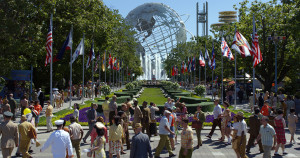 The ingenious design extends to the scenes that take place at the 1964/1965 New York World’s Fair. I have studied the fair for many years as both a designer’s dream and a pop culture touchstone. Brad Bird and his design team have recreated the fair down to the most meticulous of details. Though it may not have existed in that way in reality, it is an amazing representation – as if all those old Kodachrome slides in grandma’s attic came to life.
The ingenious design extends to the scenes that take place at the 1964/1965 New York World’s Fair. I have studied the fair for many years as both a designer’s dream and a pop culture touchstone. Brad Bird and his design team have recreated the fair down to the most meticulous of details. Though it may not have existed in that way in reality, it is an amazing representation – as if all those old Kodachrome slides in grandma’s attic came to life.
Michael Giacchino’s score is astounding. It’s filled with joy and wonder, providing an emotional background for the visuals. He never fails to bring something new and old to his style and he’s fast becoming one of my favorite film composers. My favorite section from this score is the slow buildup of what I call the “wonder” melody. It gets the audience excited for what is about to happen.
All the actors did incredible work. There was not a bad performance at all. The standouts were Britt Robertson and Raffey Cassidy. They were both believable in different ways. Robertson made Casey’s manic reactions to events believable. Cassidy gave Athena poise and presence, and her accent was adorable. I’m not usually a big fan of George Clooney, but he really gave a great performance as well.
The Not-So-Good
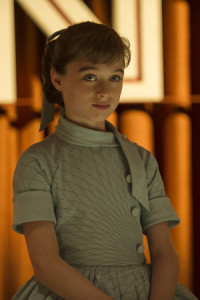 The pseudo-romance between Frank and Athena wasn’t believable or necessary, and weirded me out. He spent many years in Tomorrowland, and would have no doubt understood that Athena was an AA when she never aged. Any normal person would have been bummed, but would have eventually moved on. The fact that she was still a child when he was fully grown made things creepy. I understand that Athena was probably decades older than Frank by the time she met him, but she still looked like a child, and it was weird.
The pseudo-romance between Frank and Athena wasn’t believable or necessary, and weirded me out. He spent many years in Tomorrowland, and would have no doubt understood that Athena was an AA when she never aged. Any normal person would have been bummed, but would have eventually moved on. The fact that she was still a child when he was fully grown made things creepy. I understand that Athena was probably decades older than Frank by the time she met him, but she still looked like a child, and it was weird.
I was very frustrated that we spent so little time in Tomorrowland itself, and that Casey’s initial vision of it was just a virtual reality commercial. They spent all this time and energy building up this place and there was no real payoff. It’s the kind of place they convinced us we want to go to, but we never really go beyond a surface-level view. I wanted to see how the place worked. I wanted details. It’s like watching The Wizard of Oz, but only spending five minutes in Oz itself.
What gets me most isn’t what is in the film (though that does warrant scrutiny), but what is not. Despite a few nods, a majority of the references to Walt Disney and the parks were cut from the finished film, a choice I think hurt the film tremendously. It also betrayed their own marketing campaign.
The Japanese trailer highlighted the references to Disney, and added lines for the two AAs at the Blast From the Past store, where they said that Walt was not only one of the Plus Ultra, but that the Tomorrowlands at the parks were covers for the real thing. What an interesting idea! That Walt’s Tomorrowland could be a real place!
It was very frustrating that there was then virtually nothing Disney-related in the film itself. Though “it’s a small world” is presented (and very accurately, I might add), there was apparently a whole sequence filmed at the Carousel of Progress at Walt Disney World (one of my favorite Walt-era attractions) that was removed. Even the name “Tomorrowland” was uttered only a handful of times.
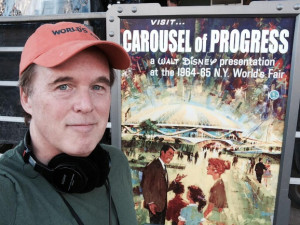 In a recent interview, Tomorrowland
In a recent interview, Tomorrowland
I’m sorry, Mr. Lindelof, but the movie is called TOMORROWLAND. The place is called TOMORROWLAND! It’s based on an area of the parks. Of course there will be winks to Walt Disney, and you’re going to say the word…a lot. The movie doesn’t make any sense without them. Putting the secret entrance to Tomorrowland at “it’s a small world” makes no sense without knowing Walt was “one of them.” Heck, the film’s entire viral marketing campaign was built upon the fact that a mysterious box was supposedly found someplace at Disney HQ, and it pointed to Walt belonging to Plus Ultra.
There were also animated sequences that were not used, which was a real shame. They helped explain the origins of Plus Ultra, something that was needed. They were interesting to look at and informative, reminiscent of the “Tomorrowland” episodes of the Disneyland TV series. I can maybe understand why they were cut, as it didn’t pertain to the story at hand, but it would have added so many more layers and added some much-needed world-building.
Though he does bear ultimate responsibility, I don’t fault Brad Bird completely. I know he’s an exceptional filmmaker based on his track record. The Incredibles and The Iron Giant are two of my favorite films. Ratatouille is one of the most perfect animated films ever made. Bird adores Disney, having been mentored by one of Disney’s original master animators, Milt Kahl. And based on his Twitter feed during production, he was genuinely excited that he got to film in the Disney Theme Parks.
I place most of the blame squarely on Damon Lindelof. Throughout all the films Lindelof has been involved in, there is a constant thread: intricately woven mysteries with big, heavy ideas, leading to a climax that doesn’t pay off or justify the mystery. One can see it in films and TV shows like Lost, Cowboys & Aliens and Star Trek Into Darkness. These were interesting high concepts, yet struggled in one way or another with a satisfying climax. I had no interest in Lost from the start, which he co-created. But based on what I’ve heard from my friends who did watch it, I’m glad I didn’t bother. The payoff was not worth it.
Lindelof doesn’t seem to understand what Walt Disney’s philosophy about the future truly was.
Themes and Thoughts
“A vista into a world of wondrous ideas…a step into the future with predictions of constructive things to come. Tomorrow offers new frontiers in science, adventure and ideas: the Atomic Age, the challenge of outer space and the hope for a peaceful, unified world.” Walt Disney at the dedication of Tomorrowland at Disneyland in 1955
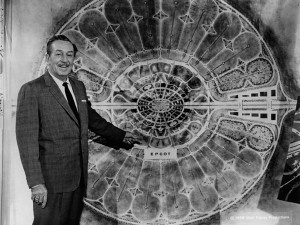 I have admired and been inspired by Walt Disney since I was very young. Like all the lands at Disneyland, Tomorrowland represented a part of Walt Disney’s personality. He was fascinated by technology and the future. In fact, he had plans toward the end of his life to take all of the ideas and knowledge he and his staff had accumulated operating Disneyland and turn it toward remaking cities to be more efficient. Walt wanted to show people that they could live better, by building what he called the Experimental Prototype Community of Tomorrow, or EPCOT. Essentially, he wanted to make Tomorrowland a reality.
I have admired and been inspired by Walt Disney since I was very young. Like all the lands at Disneyland, Tomorrowland represented a part of Walt Disney’s personality. He was fascinated by technology and the future. In fact, he had plans toward the end of his life to take all of the ideas and knowledge he and his staff had accumulated operating Disneyland and turn it toward remaking cities to be more efficient. Walt wanted to show people that they could live better, by building what he called the Experimental Prototype Community of Tomorrow, or EPCOT. Essentially, he wanted to make Tomorrowland a reality.
Damon Lindelof’s juvenile understanding of Walt’s futurism is inherent in Tomorrowland, as this city of the future is only meant for an elite few, the “dreamers.” And apparently no creative people can be good at business; never mind that even the most imaginative, creative person needs a support structure to make the dream a reality. Even Walt had it in the person of his older brother, Roy O. Disney. Roy tempered Walt’s enthusiasm with earnestness, but always strived to do what his brother wanted. Furthermore, Walt wasn’t an elitist, and wanted to inspire everyone to live better.
While I continue to admire Walt’s optimism, I am, in a way, glad he never got to see his dream of EPCOT become a reality. Don’t get me wrong; I am an optimist, always have been. And I do enjoy the EPCOT theme park as it is now. But I fear that he would have been gravely disappointed in how people would have actually used his idea once they started to live in his model city. Would it have inspired others? I’m sure of it. But what Walt was banking on was utopia, and that is something that is incompatible with the nature of man.
Walt Disney, and many like him, believed and continue to believe that man can “evolve” beyond his sinful nature with simply knowledge, drive and imagination. While those things are important, the heart needs to be tempered more than the mind. As the animated clip explained, knowledge, “if left ungoverned by conscience, can lead to destruction.”
Hugh Laurie’s David Nix exemplifies this idea. He hopes that man will somehow transcend the violence in his heart, and becomes frustrated when he sees the reality of the situation toward the end of the film.
“All around you the coal mine canaries are dropping dead and you won’t take the hint! In every moment there’s a possibility of a better future, but you people won’t believe it. And because you won’t believe it you won’t do what is necessary to make it a reality.” David Nix
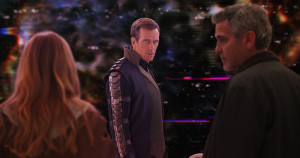 Nix is an elitist and a monster for willingly allowing his fellow human beings to destroy themselves. But in this particular point in the film, he was right about something: humans are terrible. We are sinful creatures who squander what God has given us time and again. There is a clock ticking down, and this world will end, though no person knows the time except God (Matthew 24:36).
Nix is an elitist and a monster for willingly allowing his fellow human beings to destroy themselves. But in this particular point in the film, he was right about something: humans are terrible. We are sinful creatures who squander what God has given us time and again. There is a clock ticking down, and this world will end, though no person knows the time except God (Matthew 24:36).
It’s not misanthropic to say this; it is simply the truth. If we put our hope in our fellow human beings – be they politicians and celebrities, or artists and the like – we will always be disappointed. As the apostle Paul pointed out in the Book of Romans:
“There is no one righteous, not even one; there is no one who understands; there is no one who seeks God. All have turned away, they have together become worthless: there is no one who does good, not even one. Their throats are open graves; their tongues practice deceit. The poison of vipers is on their lips. Their mouths are full of cursing and bitterness. Their feet are swift to shed blood; ruin and misery mark their ways, and the way of peace they do not know. There is no fear of God before their eyes.” Romans 3:10-18
We are all equally guilty of sin, including the brilliant minds like Governor Nix – as displayed by his indifference to humanity. Regardless of his intelligence and ingenuity, Nix is not perfect, and has no justifiable reason to shut humanity out. God, on the other hand, is perfect and would be justified in allowing us to die in our sin.
“God presented Christ as a sacrifice of atonement, through the shedding of His blood — to be received by faith. He did this to demonstrate His righteousness, because in His forbearance He had left the sins committed beforehand unpunished— He did it to demonstrate his righteousness at the present time, so as to be just and the one who justifies those who have faith in Jesus.” Romans 3:25-26
God is love, and showed that love through the mercy He bestowed upon us through Jesus Christ. While inspiration is a wonderful thing, Jesus didn’t come to just inspire; He came to love and save us from ourselves. He came to be Lord of all, not just a select few. Though we should strive to make the world a better place in His name, our ultimate fate has already been fixed by Jesus.
We can and should inspire others to do good in this world. It is what our Lord desires. However, it is for His ultimate glory, and to point fellow sinners to Him.
Conclusion
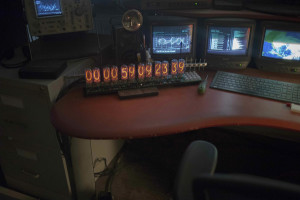 Tomorrowland is a decent film, with excellent moments. It’s fast and fun, with lots of visual goodies. It’s a tribute to the futurists of the past, and asks important questions about our future. The ideas are there, and they are good ones. Unfortunately, questions are brought up in the story that are never answered, and things that would have benefitted the story were intentionally left out. These questions would have been mostly answered simply with more time and exposition in the world of Tomorrowland itself.
Tomorrowland is a decent film, with excellent moments. It’s fast and fun, with lots of visual goodies. It’s a tribute to the futurists of the past, and asks important questions about our future. The ideas are there, and they are good ones. Unfortunately, questions are brought up in the story that are never answered, and things that would have benefitted the story were intentionally left out. These questions would have been mostly answered simply with more time and exposition in the world of Tomorrowland itself.
This film succeeds thematically in being very optimistic about the future, but what kind of future should people put their hopes in?
People want to hope in the future. But should we put our hope in men, who are corruptible? Or technology? No. We were built to hope for something more. Tomorrowland, the place and film, exemplifies people’s want for a heaven on earth. We should put our hope in God, for His love never fails even in the darkest of times. And you don’t need a pin to receive His perfect love; just a faithful heart willing to turn from sin.
Have faith that there is indeed a “great, big beautiful tomorrow” found with God Almighty.


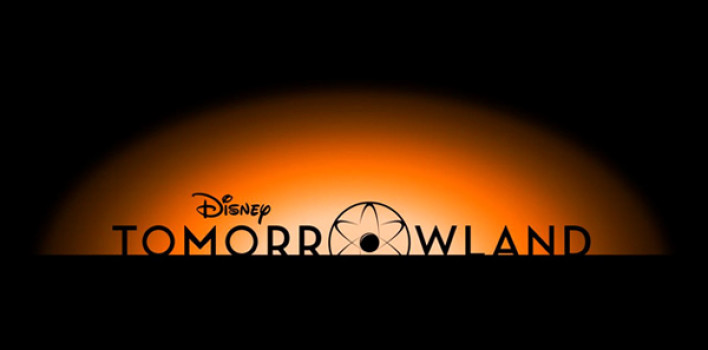
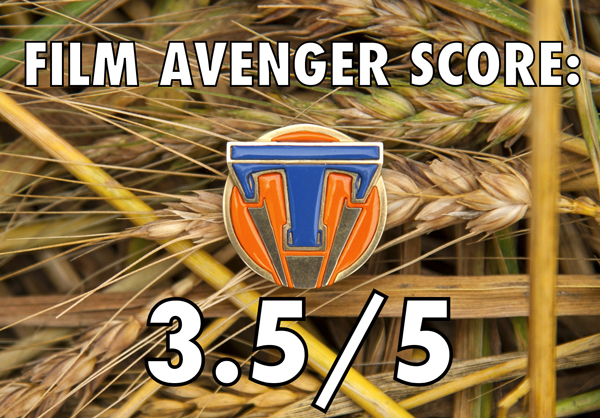
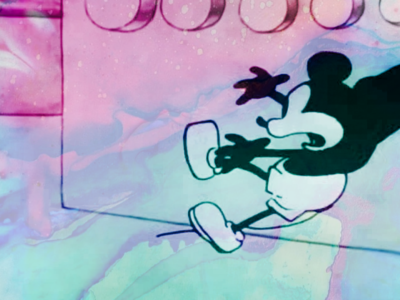
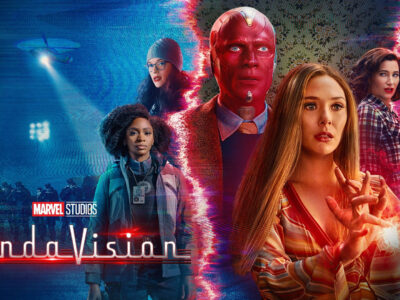
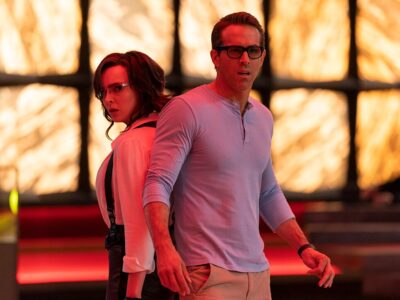


Nice review – on point. Thanks.